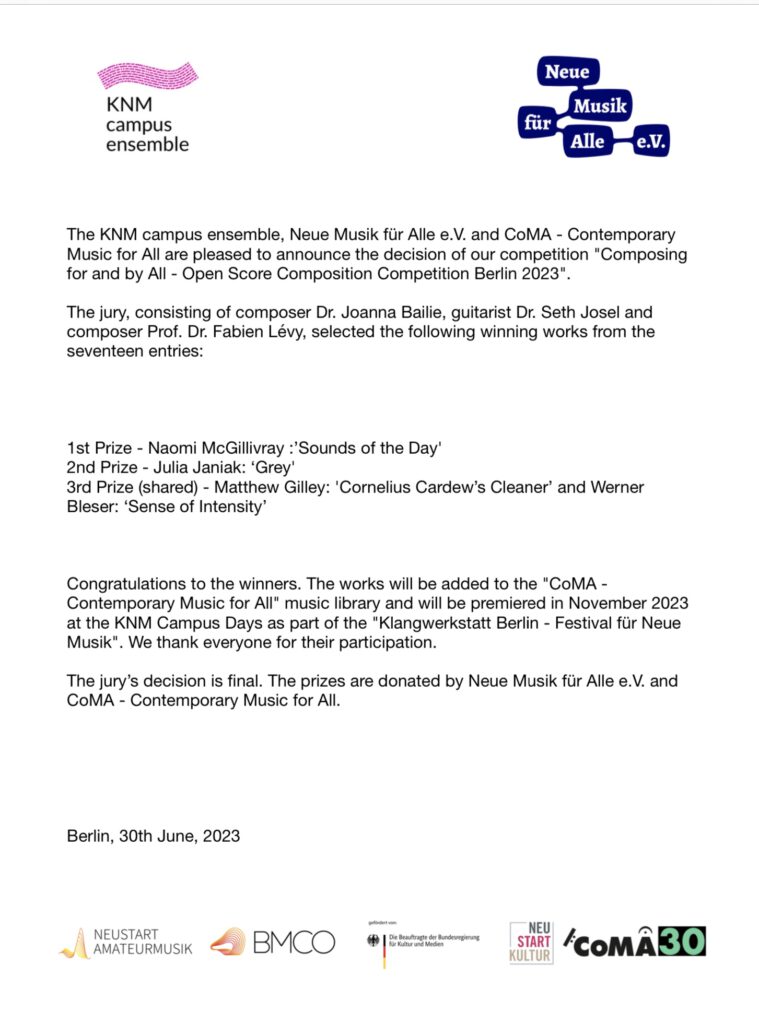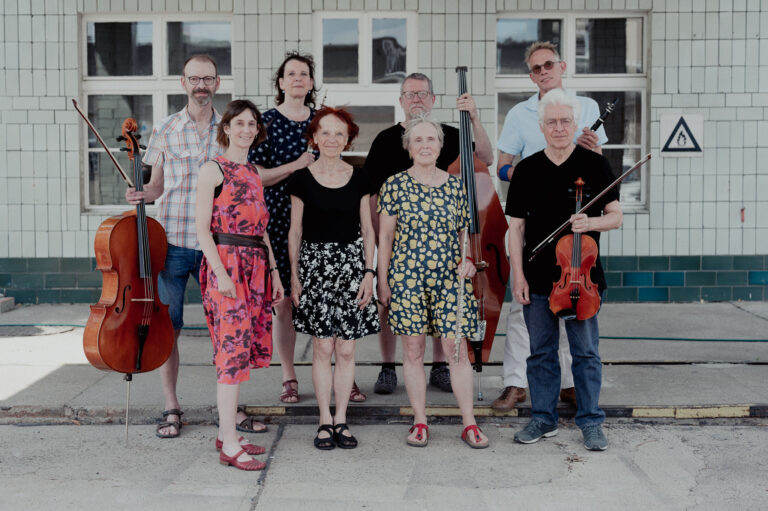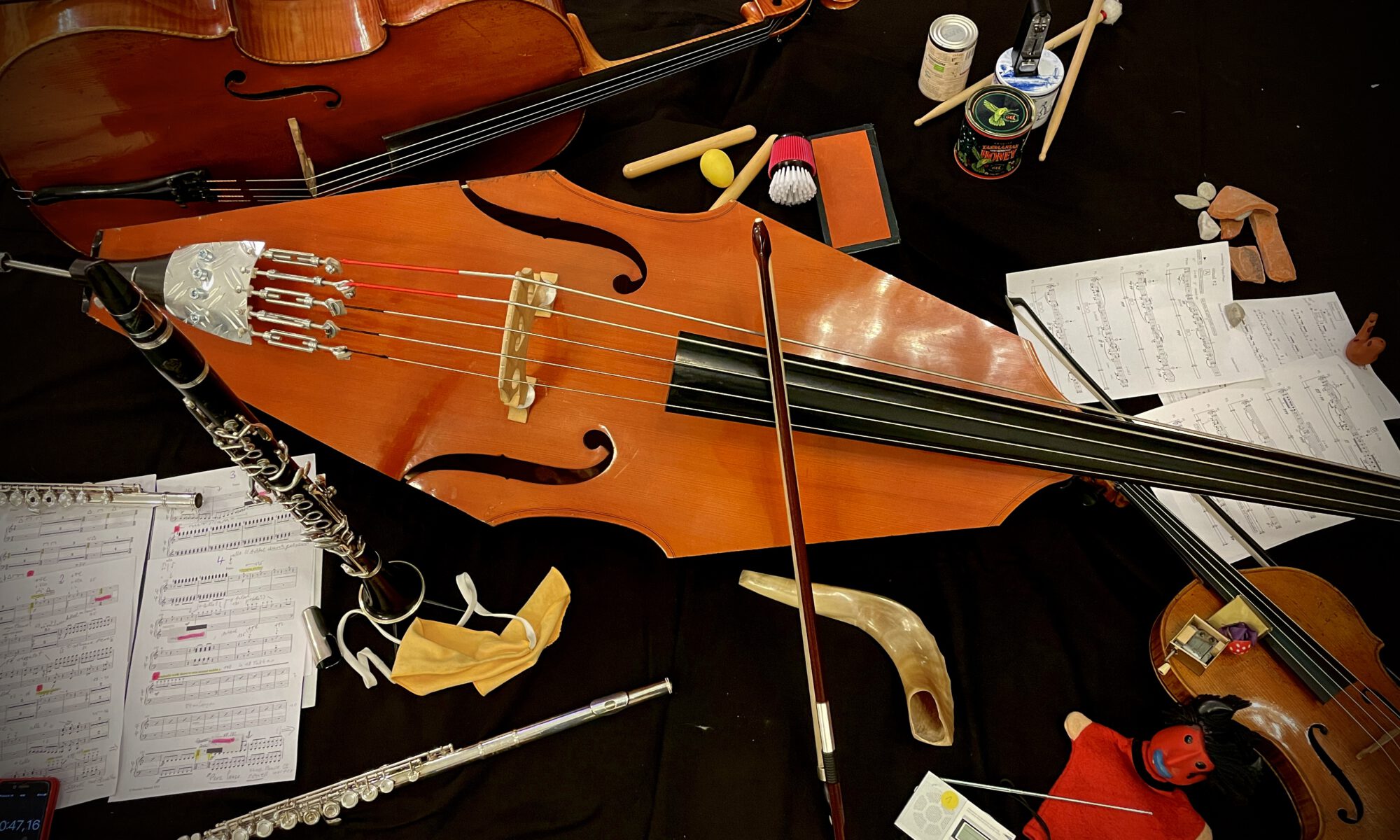For the first time, the KNM campus ensemble and the association Neue Musik für Alle e.V. held a composition competition. Under the title „Composing for and by All – Open Score Composition Competition Berlin 2023 – March to June 2023“, composers were invited to submit works for amateur ensembles in open score format (i.e. without fixed instrumentation). Six pieces were chosen by the jury to be played in a workshop given by KNM campus ensemble in June, which could then be revised before the second jury round. Four prizes were awarded from the shortlist.
The jury, consisting of Dr. Joanna Bailie (composer, GB/GER), Dr. Seth Josel (musician, USA/GER), Prof. Dr. Fabien Lévy (composer, Prof. for composition at Hochschule für Musik und Theater „Felix Mendelssohn-Bartholdy“ in Leipzig, FR/GER) selected the following compositions:
1st Prize – Naomi McGillivray: ‚Sounds of the Day‘
2nd Prize – Julia Janiak: ‚Grey
3rd Prize (shared) – Matthew Gilley: ‚Cornelius Cardew’s Cleaner‘ and Werner Bleser: ‚Sense of Intensity”.
There were seventeen entries in all from Brazil, the Netherlands, Great Britain, USA, Belgium, Estonia/Germany, Italy and of these ten were male and six were female composers (one composer submitted two pieces). Overall, the entries were of good to very good quality. The type and notation of the compositions were very varied, for example two purely graphic pieces were submitted. Three works were based on texts or a poem.
The prize-winning works will be premiered at the „KNM Campus Days“ in November 2023 in Berlin and will also be included in the library of the international association „CoMA – Contemporary Music for All“.
The original plan was to invite the six shortlisted composers to the workshop in Berlin. Due to the worldwide distribution of the competition and the international submissions, the workshop was partly conducted online, while three composers travelled to Berlin. This had the advantage that the workshop as a whole could be recorded.
The announcement of the competition was spread through partner organisations such as „CoMA – Contemporary Music for All“ and social networks.
The KNM campus ensemble is the only all-age amateur contemporary music ensemble in Germany. Supported by the association Neue Musik für Alle e.V., the ensemble promotes the dissemination of contemporary music through amateur performance.
This project was made possible by the generous support from “Neustart Amateurmusik“ und “Contemporary Music for All“.

KNM campus ensemble and Neue Musik für Alle e.V. are pleased to announce an international composition competition in collaboration with CoMA (Contemporary Music for All). The competition is open to composers and students of all genres who write works for amateur ensembles in open score format.
Of the pieces submitted, six composers will be invited to participate in a workshop in Berlin with the KNM campus ensemble. Three works will be awarded prizes and premiered at the Klangwerkstatt Berlin – Festival für Neue Musik in November 2023. The scores will then be available to purchase from CoMA’s international library.
Composing for and by All – Berlin 2023
CONDITIONS AND GUIDELINES
‘OPEN SCORE’ COMPOSITION COMPETITION
March – June 2023
Dear composer,
We are very happy that you are considering taking part in the KNM campus ensemble Composition Competition. This contest has been set up to challenge you to submit works for flexible amateur ensemble. Next to important general information you will find the conditions for the contest as well as technical guidelines around ‘open score’ composing below. If you have any questions, please don’t hesitate to contact us via campus@kammerensemble.de
We wish you a creative and inspiring composing time.
General information
Open Score: what does it mean?
*all information below is based on the Open Score Guidelines and Requirements as issued by CoMA UK of which KNM campus ensemble is a partner ensemble
Flexible scoring
CoMA ensembles vary in size, instrumentation and instrumental skills of the (mostly amateur) musicians. So we ask composers to submit flexible scores which are accessible for performance by different numbers and combinations of instruments. Even if the work has a preferred instrumentation, pieces must be playable using many different combinations of instruments. Besides that pieces must be playable by musicians of different levels (from relatively beginner up to advanced). Parts can be divided into different levels if you wish.
Options for and examples of flexible scoring
- Four part score (with or without optional parts)
Flexible scores should consist of four parts. Mostly a number of different instruments will play from each part.
You may also include parts for keyboard and percussion or provide them as ‘optional’ parts as not every ensemble has a pianist and/or percussionist at hand. Vocal parts may be added as well, preferably as ‘optional’ parts.
The following is a typical division of parts:
Part 1 upper range:
-‐ e.g., violin, flute, oboe, clarinet
Part 2 upper middle range:
-‐ e.g., violin, oboe, clarinet, viola, alto saxophone, trumpet
Part 3 lower middle range:
-‐ e.g., viola, tenor saxophone, French horn, tenor horn, bassoon, trombone, guitar
Part 4 lower range:
-‐ e.g., cello, double bass, bassoon, trombone, euphonium, tuba, bass guitar
keyboard (piano or electronic keyboard) – normally one player only
percussion – normally one player only
Examples:
Donnacha Dennehy – A Fatal Optimist http://www.coma.org/catalogue/a-fatal-optimist/
Gabriel Jackson – Melancholy Procession http://www.coma.org/catalogue/melancholy-processional/
Michael Nyman – In C Interlude http://www.coma.org/catalogue/in-c-interlude/
Howard Skempton – Sirens for Orchestra http://www.coma.org/catalogue/sirens-for-orchestra/
- Playing from the score
In this case there don’t have to be any separate parts. All instruments can play from the score but if that goes over several pages, it is better to provide parts. It is up to the composer whether he/she wants instruments to play from a score in concert pitch C without transposing or whether transposed scores are needed. Some works give the players full freedom to play their own notes or a choice of notes.
Examples:
Paul Burnell – 4 Minutes, 4 Daydreams http://www.coma.org/catalogue/four-minutes-four-daydreams/
Jonathan Harvey – Climbing Frame http://www.coma.org/catalogue/climbing-frame/
Philip Venables – Dutch Courage http://www.coma.org/catalogue/dutch-courage/
There are separate parts for the Venables.
- Graphic scores
Graphic scores should be accompanied with clear instructions for the players, many of them not having (a lot of) experience in playing from graphic scores.
- Use of tapes and/or videos
This is allowed as long as the necessary equipment needed is very simple, i.e. a laptop/smartphone connected with a simple speaker/beamer.
Example:
Joanna Bailie – Hildegardstrasse/Bundesalle
http://www.coma.org/catalogue/hildegardstrasse-bundesalle/
More scores of a large number of CoMA works (and some recordings) are available online at http://www.coma.org/library
Eligible participants:
All composers and composition students who can submit works suitable or flexible (amateur) ensemble.
Jury members
Joanna Bailie (composer, GB/GER), Seth Josel (musician, USA/GER), Prof. Dr. Fabien Lévy (composer, Prof. for composition at Hochschule für Musik und Theater “Felix Mendelssohn-Bartholdy” in Leipzig, FR/GER)
Timeline
January – May writing composition
15th May 2023 application deadline
End of May 6 pieces will be chosen by the jury
June workshops of 6 nominated works in Berlin with KNM campus ensemble
23rd June 2023 application deadline for updated works
End of June 2023 Jury confers
30th June 2023 Results of the competition
Prizes
1st prize € 900, 2nd prize € 500, 3rd prize € 300
The three shortlisted compositions will be included in the online CoMA Library. KNM campus ensemble will promote the three winning pieces to be played at public concerts in the near future.
Reimbursement of expenses
KNM campus ensemble will contribute 100 € towards travelling expenses for the 6 finalists travelling to the workshops in Berlin.
Conditions
- 15th May 2023 is the deadline to submit your score
- The length of your composition should be 5 to 8 minutes
- The use of tapes/videos is allowed, but keep in mind that CoMA ensembles in general don’t have sophisticated technical devices available
- The use of separate Electronics is NOT permitted, with a view to the playability of the work by amateurs
- Compositions should be demonstrably ‘new’ and have never been published and/or performed in public before
- The score has to be delivered in Pdf format
- If applicable add tape/video
- As the judging of scores will take place anonymously don’t add your name to the score
- You don’t have to add separate parts
- More specific information about score (and part) preparation below
Rights
KNM campus ensemble will be entitled to the performing rights of the premiers of the composition.
CoMA UK will be entitled to include the three shortlisted compositions in their library.
Send your score to: Rebecca Lenton campus@kammerensemble.de
Mention clearly your name (but not on the score!), town of residency, country, email address and mobile number please
Guidelines for Open Score composing
Score preparation
For your information: KNM campus ensemble currently has the following instruments:
2 flutes, 1 clarinet, 1 viola, 1 cello, 1 double bass, 1 – 2 pianists, percussion.
Please ensure that your score covers the following points:
- The score should have a title, and if appropriate a short descriptive programme note.
- The title of the piece should be written on each page!
- Any special performance instructions that apply to the whole piece should be clearly mentioned at the beginning of the score.
- For ‘Open Score’ pieces (flexible scoring), the score should show all parts ‘in C’, i.e., not transposed.
- Bar numbers must be shown in all pieces. In longer pieces, rehearsal letters should also be used.
- The initial tempo and all tempo changes must be clearly marked.
- Metronome marks should be used where possible.
- Order of staves (in case of m ore parts)
-‐ If there are any solo instruments, their parts should appear at the top of the score.
-‐ Then place the ensemble parts in order of tessitura – Parts 1,2,3,4, etc.
-‐ The Keyboard part(s), if any, should be placed below the ensemble parts.
-‐ The Percussion part(s), if any, should be placed at the bottom of the score.
- For keyboard, the part can be a stand-alone part or a supporting part, e.g. combining part 1 and 2 in the right hand and part 3 and 4 in the left hand.
- Percussion: note that in CoMA ensembles, percussion is usually played by a non-‐specialist. And often there is only one percussionist available.
- For percussion, list the instruments/timbres and the number of percussionists required on the score.
- The percussion instruments available vary between ensembles, so please suggest alternatives.
- For untuned percussion, specifying a generic timbre rather than a specific instrument is flexible and useful -‐ e.g., drum, wood or metal.
- Tuned percussion instruments (if available) may be assigned to one of the four basic ensemble parts.
- Ensure the score is printed large enough to be easily legible, e.g., if using Sibelius, use not less than staff size 6.6 in the score.
- Score should be made available in PDF format.
Part preparation (only on request)
In case your composition has been elected for the final or selected for a workshop on the festival day, you should provide parts in all transpositions for the CoMA ensembles.
Please ensure that your part preparation covers the following points:
- Any special performance instructions that apply to the whole piece should appear in the parts if appropriate.
- Please try to avoid difficult page turns in the parts wherever possible.
- Bar numbers must be shown in all pieces. In longer pieces, rehearsal letters should also be used.
- The initial tempo and all tempo changes must be clearly marked.
- Metronome marks should be used where possible.
- Use only one stave per part unless the part contains complicated divisi passages.
- The parts should be clearly labelled with the title of the piece, part number, transposition and clef – e.g., ‘Part 1 in C Treble’; ‘Part 2 in Bb Treble’; etc. on each page.
- Some parts may need extra clarification. For example, if you provide two versions of Part 3, one for clarinet and one for tenor sax, the transpositions are different by an octave. The clarinet part should be ‘Part 3 in Bb Treble (Clr)’; the sax part should be ‘Part 3 in Bb Treble (Sax)’.
- Where the piece is for specific instrumentation, including transposing instruments, appropriate parts are required.
- Try to use clefs for each part which are appropriate to the tessitura of the music – e.g., alto clef may be used for part 3.
- For percussion, list the instruments/timbres and the number of percussionists required at the beginning of the part.
- For untuned percussion, specifying a generic timbre rather than a specific instrument is flexible and useful -‐ e.g., drum, wood or metal.
- Tuned percussion instruments (if available) may be assigned to one of the four basic ensemble parts.
- For percussion, lay out the part either in instrumental groupings (tuned and untuned), or on one continuous line, but do not use multiple separate parts. Show instrument changes clearly. Be consistent about the use of specific stave lines/space for specific sounds.
- Parts should be made available in PDF format.
- If you use Sibelius or other music notation software, it would be useful (but not essential) to have a copy of the source file available, so that CoMA can more easily generate any additional parts or transpositions that may be necessary.
Allocation of instruments to parts
The following table gives a rough guide to how the most common instruments may be assigned to different parts in the ensemble. In most cases, one part can serve for several instruments. E.g., Part 1 in C Treble Clef could be given to Flute, Oboe and Violin. Part 4 in C Bass Clef could be given to cello, bassoon, trombone and double bass, but bear in mind that in this case the double bass will sound an octave lower than written.
| Part No. | Clef | Transposition | Instrument |
| Part 1 | |||
| 1.1 | Treble | Concert pitch | FluteOboeViolinAlto (treble) recorderTenor recorder |
| 1.2 | Treble | Bb, tone higher than sounding | Clarinet in BbSoprano SaxophoneTrumpet |
| 1.3 | Treble | Eb, minor 3rd lower than sounding | Eb Clarinet(Cornet/trumpet in Eb) |
| 1.4 | Treble | C, octave lower than sounding | PiccoloGlockenspielXylophoneSoprano (descant) recorder |
| 1.5 | Treble | A, minor 3rd higher than sounding | Clarinet in A |
| Part 2 | |||
| 2.1 | Treble | Concert pitch | FluteOboeViolinAlto (treble) recorderTenor recorderBass recorder |
| 2.2 | Treble | Bb, tone higher than sounding | Clarinet in BbSoprano SaxophoneTrumpet |
| 2.3 | Treble | Eb, major 6th higher than sounding | Alto SaxophoneTenor HornAlto clarinet |
| 2.4 | Alto | Concert pitch | Viola |
| 2.5 | Treble | F, perfect 5th higher than sounding | Horn in FCor Anglais |
| 2.6 | Treble | C, octave higher than sounding | Guitar |
| Part 3 | |||
| 3.1 | Alto | Concert pitch | Viola |
| 3.2 | Bass/ Tenor | Concert pitch | BassoonTromboneCello |
| 3.3 | Bass | Concert pitch | Euphonium/baritone/trombone (bass clef) |
| 3.4 | Treble | Bb, major 9th higher than sounding | Bass clarinetTenor SaxophoneEuphonium/baritone/trombone (treble clef) |
| 3.5 | Treble | Bb, tone higher than sounding | Clarinet in BbTrumpet |
| 3.6 | Treble | F, perfect 5th higher than sounding | Horn in FCor Anglais |
| 3.7 | Treble | C, octave higher than sounding | Guitar |
| Part 4 | |||
| 4.1 | Bass/ tenor | Concert pitch | BassoonTromboneCello |
| 4.2 | Bass | Concert pitch | Euphonium/baritone/trombone (bass clef)Tuba |
| 4.3 | Treble | Eb, major 13th higher than sounding | Baritone SaxophoneEb tuba (treble clef)Contra alto clarinet |
| 4.4 | Treble | Bb, major 9th higher than sounding | Bass clarinetTenor SaxophoneEuphonium/baritone/trombone (treble clef) |
| 4.5 | Treble | Bb, major 16th higher than sounding | Contrabass clarinetBBb tuba (treble clef)Bass saxophone |
| 4.6 | Bass | C, octave higher than sounding | Double BassContrabassoon |



